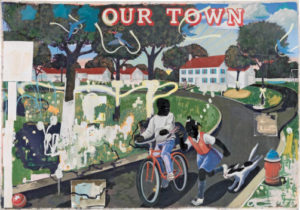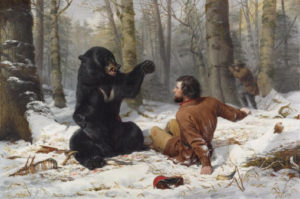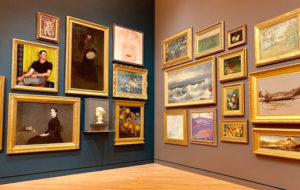The Walmart funded Crystal Bridges Museum of American Art is a just right museum located in the suburban wilds of Walmartania (international HQ) in Bentonville, Arkansas; a company town with miles of cookie-cutter mini-mansion neighborhoods. An inside tour of any randomly chosen five of these houses would make a GREAT photo exhibit at, say, Crystal Bridges. I’d go; wouldn’t you?
The exterior of the museum is an ambitiously modernist design that tries too hard to say “internationally important over here.” It ends up being clunky, over-built, and – despite claims of “fitting the landscape” – an awkward intrusion in the lovely Arkansas hills where it’s plopped. There is a small Frank Lloyd Wright house reset on the property that shows what a true architectural artist can do for $20k in 1950s dollars. The pretentious $1.2b museum building loses big in comparison. Subtly subversive to put the Wright house there, though.
Inside, however, it has a nice flow, good light, and a really lovely and broad collection of American art, spanning the country’s history. The day I visited there was a mix of made-for-museum paintings, watercolors, tempera (!), sculpture, private works, and pieces commissioned for Crystal Bridges. The 21st century section had a surprising number of pieces by African-American artists, including some interesting political work. Surprising and interesting because, you know, the Waltons.
 “Our Town” Kerry James Marshall
“Our Town” Kerry James Marshall
Women artists were also well represented. Whoever curates this collection (currently, Margaret Conrads) has it going on, art-wise. That, plus the Walton billions, makes the collection a tasty madeleine in the super family-size bag of Ozark ranch Doritos. To stretch a metaphor.
There were some surprises; a Hopper and an Andrew Wyeth I hadn’t seen before, a late George Segal (in color!), some charming Calder mobiles, and some really funny paintings, including this one:
 “A Tight Fix” it’s called. In real life, it’s clear that the protagonist’s friend is aiming at something out of frame – not the bear. Another, bigger bear? A really trophy deer? We don’t know. Also, this little bear doesn’t seem that in to attacking the guy. Maybe it’s the other way round? All-in-all, less than heroic. But funny. There are several laugh-out-loud pieces, some intentional, some not.
“A Tight Fix” it’s called. In real life, it’s clear that the protagonist’s friend is aiming at something out of frame – not the bear. Another, bigger bear? A really trophy deer? We don’t know. Also, this little bear doesn’t seem that in to attacking the guy. Maybe it’s the other way round? All-in-all, less than heroic. But funny. There are several laugh-out-loud pieces, some intentional, some not.
Though we walked the museum backwards (present to past), I was relieved to finally find something to be critical of. The framing of the early paintings was weird. All the frames are the same color of bright, new-wedding-ring gold: no patina, no age, no depth. They are, they say, the original frames. Except: many – maybe most – are out of proportion to the art they’re framing! Yes, exclamation point. Some frames are, in total yardage, twice the size of the poor little painting they encompass. Crystal Bridges gives frame tours and a frame page on their website, so they’re aware and proud of the frames. But the nouveau riche GOLD! does disservice to the art and the collection.
 There’s worse than this, although I kinda liked the old fashioned stacked display. For a more erudite analysis of the place, check out this Art in America review.
There’s worse than this, although I kinda liked the old fashioned stacked display. For a more erudite analysis of the place, check out this Art in America review.
One can’t responsibly talk about the billiony-billionaire Walton kids without mentioning how they gip the American people out of millions by instructing their under-paid Walmart employees in how to get food stamps to survive their minimum wage jobs. So, the largesse of this nice, free museum is balanced by the greed of its main benefactor, Alice Walton, whose genius was to be born the child of Sam Walton.
Could they afford to pay living wages? Of course. Should you boycott Crystal Bridges because of the tainted money? Hard to call. You don’t pay to get in. You don’t have to ever shop at Walmart to get in. You can ask awkward questions of the friendly staff. You can elect people who will tax these folks accordingly. Since the advent of public museums (only the last 200 years or so) this has been the contract: “I’ll let you occasionally see the fabulous stuff that I can see daily; you let me keep on keeping on. And maybe, someday, you’ll be rich like me!” Doesn’t it always get back to the American Dream? Which, like the lottery, is just enough of the slightest possibility to keep we masses crossing our fingers and giving the wealthy a pass.
Enjoy the art.

